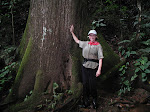Guayaquil and Cenizaro
Everybody said the tree was a Cenizaro (Samanea saman MIMOSAC) but it sure looked like a Guayaquil to me! (Pseudosamea syn. Albizia saman MIMOSAC)
A highly regarded botanist 1st called it a Cenizaro – and when I insisted that the square flaky bark didn’t signify, he insisted that he was right. Confused, I checked the article showing the difference between the two and emailed him the article. And I wrote him that the article clearly differentiated between the bark of the two and that it had to be a Guayaquil. So there! Be more humble!
Well, I a few months later, I invited the author of that article to Finca El Tigre to show him the Guayaquil. This is a well known Forestry Engineer with a vast memory for trees and a passion for the forest. He looked at the tree and proclaimed it a Cenizaro.
I sputtered: But what about the bark??? How can you call it a Cenizaro when the bark looks like that of a Guayaquil – as you posted on your website!
He calmly answered – it’s very easy to tell that it’s a Cenizaro by looking at the leaves. The leaves on that tree are stiffer and more upright, whereas the leaves of the Guayaquil are more floppy. We looked way up at the pinnate leaves on the tree and they did indeed seem stiffer and not at all floppy.
I was now really beginning to doubt myself and felt really stupid sending that botanist a note telling him to be humble when it was I who was humbled.
A few months after that, a visiting dendrologist also referred to the tree as Cenizaro. He said Guayaquil didn’t grow in our region. I was done in- a total disaster as an amateur botanist. If all those distinguished botanists identified it as a Cenizaro, then it was Cenizaro. Y punto.
All this happened about a year ago. So last week, I invite another amateur botanist out to visit the finca. When we got to the tree, I pointed it out as a Cenizaro. She immediately bristled, pointed out the bark, and said, well, it looks like a Guayaquil to me! When I told her the whole story, she sort of doubted her abilities too but, now my curiosity was piqued.
So I asked the Finca caretaker who was hiking with us: Armando, are there any more Cenizaro trees about that might have branches low enough to grab the leaf? He said yes and knew exactly where they were. He guided us down a trail, which I had not actually explored before, and there we beheld a grove of Cenizaro. But then we looked – there were both Cenizaro and Guayaquil trees all mixed together! The difference in the bark really stood out when looking at them both together. We got a leaf from the Guayaquil and sure enough, found the telltale gland located on the petiole. It WAS a Guayaquil!
Then we walked back to the “Cenizaro” and could definitely see it had identical bark to the other trees – square, light color flaky bark! We nailed it! It was a Guayaquil and all those distinguished botanists had made a mistake!
Should I email them with the evidence and tell them to be humble? No way! I don’t respect them any less – tropical dendrology is so complex that it humbles us all. But perhaps this experience has given me a bit more confidence to investigate mysteries on my own and not rely solely on experts.
So what is that jobo with the smooth bark, anyway? It’s not Spondias mombin….but that yellow fruit sure does look like a jobo! And no it’s not a jocote iguanero and it can’t be that Tapirira brenesii, despite what that forestry engineer said…
Monday, September 18, 2006
Subscribe to:
Comments (Atom)

